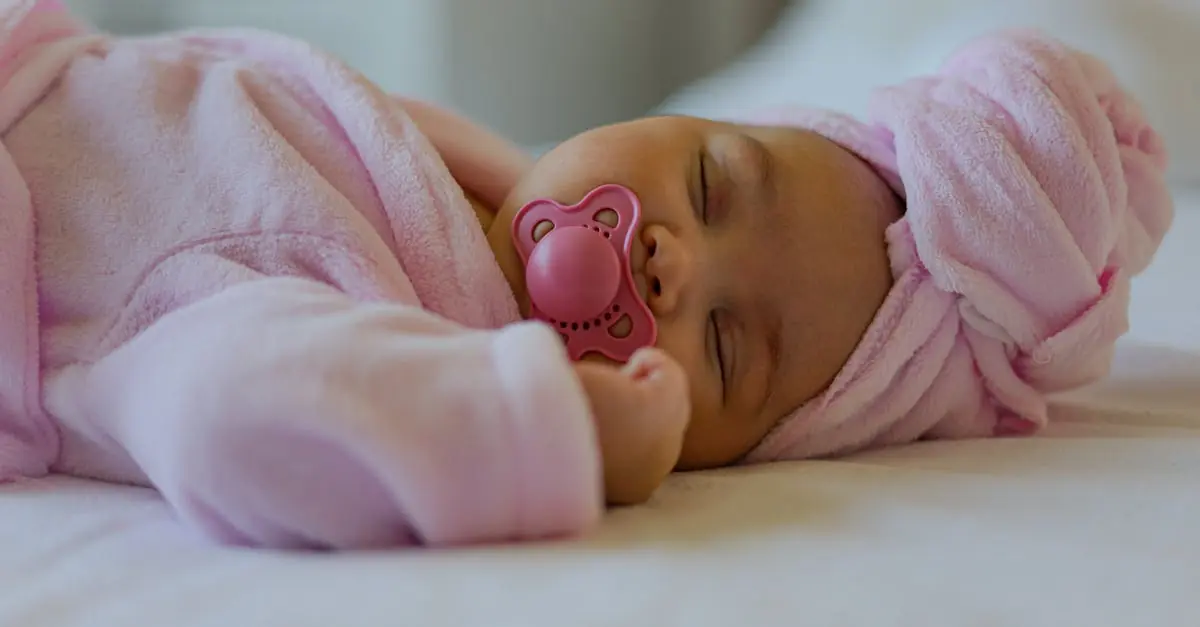When it comes to getting a good night’s sleep, parents often find themselves in a tug-of-war with their little ones. Enter the pacifier—the tiny superhero of the nursery that promises to soothe fussy babies and grant parents a few precious moments of peace. But can babies really sleep with these magical little gadgets, or are they just a one-way ticket to a drool-soaked pillow?
Table of Contents
ToggleUnderstanding Pacifiers
Pacifiers play a significant role in many infants’ lives, providing comfort and calming effects. They can help soothe fussy babies and support better sleep patterns for some.
What Are Pacifiers?
Pacifiers are small, nipple-shaped devices designed for infants to suck on. These items often consist of silicone or rubber materials. While commonly used, they may vary in shape and style. A typical pacifier includes a shield to prevent choking and a handle for easy grasping. Different designs cater to various age groups, ensuring safe usage.
Why Do Babies Use Pacifiers?
Babies often use pacifiers for several reasons. Firstly, the act of sucking provides comfort and security. Many infants have a natural reflex to suck, which helps them self-soothe. Additionally, parents may notice their babies sleep longer when given pacifiers. Another reason is that pacifiers can reduce the risk of sudden infant death syndrome (SIDS) during sleep. Some infants find pacifiers helpful during teething, easing discomfort associated with emerging teeth.
Safety Considerations
Pacifiers can provide comfort for infants, but safety must be a priority. Parents should consider various factors when deciding whether to allow babies to sleep with pacifiers.
SIDS and Pacifiers
Using pacifiers during sleep may lower the risk of sudden infant death syndrome (SIDS). Research indicates that pacifier use decreases SIDS incidents by keeping airways open. Infants who use pacifiers are less likely to roll onto their stomachs during sleep, a position linked with higher SIDS risk. It’s essential to note that exclusive breastfed babies may experience different risks, as pacifier introduction should ideally occur after establishing breastfeeding routines. Health professionals often recommend pacifier use during sleep times for added safety.
Risks of Pacifier Use
Certain risks accompany pacifier use for sleeping infants. Potential ear infections arise with prolonged pacifier use, as bacteria can transfer from the pacifier to the ears, increasing infection likelihood. Additionally, dental issues may develop if a pacifier is used for an extended period since it can alter oral cavity structure. Choking hazards also exist if the pacifier breaks or if it becomes lodged in the baby’s throat. Regular inspection for wear and appropriate size selection are crucial to minimizing these risks. Parents must weigh these factors against the benefits when deciding on pacifier use during sleep.
Benefits of Pacifiers for Sleep
Pacifiers offer several advantages for promoting better sleep in infants. They serve as comfort items that can help soothe babies and facilitate longer periods of rest.
Comfort and Soothing
Pacifiers provide instant comfort by satisfying infants’ natural sucking reflexes. Many babies find sucking calming, which helps ease fussiness. Comfort is essential for babies, as it leads to quicker settling and less crying during bedtime. The act of sucking releases endorphins, offering emotional relief and promoting relaxation. A pacifier can also create a positive sleep association, making bedtime feel more secure and familiar to babies.
Sleep Training with Pacifiers
Pacifiers can assist in sleep training by establishing a bedtime routine. Parents may incorporate pacifier use as part of a consistent calming strategy that signals sleep time. When used appropriately, they encourage self-soothing, allowing babies to transition into sleep independently. Gradual weaning from the pacifier can occur once an infant develops solid sleep habits, usually around six months. This gradual approach minimizes reliance on the pacifier while maintaining the calming benefits it provides.
Alternative Sleep Solutions
Parents often explore various alternatives to pacifiers for soothing babies to sleep. These methods can provide comfort while addressing safety concerns.
Other Soothing Methods
Swaddling serves as an effective option, mimicking the womb’s comforting environment. Rocking gently can help infants relax and fall asleep more easily. White noise machines create a calming atmosphere that masks disruptive sounds. Utilizing warm baths before bedtime can promote relaxation and signal that sleep is approaching. Lastly, offering a soft toy or blanket can provide a sense of security as babies drift off to sleep.
When to Limit Pacifier Use
Limiting pacifier use becomes essential as babies reach certain developmental milestones. Around six months, babies may start sleeping longer, reducing dependency on pacifiers. As they grow, too much use could lead to dental issues or ear infections. Monitoring daytime use helps establish appropriate boundaries. Gradually weaning from pacifiers encourages self-soothing skills, promoting healthier sleep habits. Setting clear guidelines allows infants to transition away from pacifiers smoothly.
Deciding whether to let babies sleep with pacifiers involves weighing the soothing benefits against potential risks. Pacifiers can provide comfort and help babies settle down for longer sleep periods. They may also reduce the risk of SIDS when used correctly.
However parents need to stay vigilant about safety issues and consider alternatives that promote healthy sleep habits. Gradual weaning from pacifiers can foster independence in sleep routines. Ultimately each family should assess their unique situation and choose what works best for their baby’s needs.




